[FKPXLS] VOL.49 / Ideas that affect us like a disaster
Sometimes we forget why we read. If we agree with everything we read, then what use is education?


Hey, you are here. Welcome to Fakepixles, a space fostering nuanced dialogues, creative courage, and deep thinking. We ask big questions and aim to find answers by bringing together the most brilliant and eclectic minds from all lanes of life.
If you’re a writer, designer, creative technologist, venture builder who wants to contribute. Drop a line and bring a friend.

Recently, the two extremes of the debate are converging into one ideology, one that neglects the in-between and eventually threatens not only democracy. As Orwell wrote in 1946 essay “The Prevention of Literature”:
What is sinister is that the conscious enemies of liberty are those to whom liberty ought to mean most […] They do not see that any attack on intellectual liberty, and on the concept of objective truth, threatens, in the long run, every department of thought.
That includes technology, includes the arts, includes things we hold dear as humans. Increasingly so, what is important is not so much to defend culture as to extract ideas whose force is identical with that of hunger.
Franz Kafka, at the age 20, wrote in a letter to his friend Pollack:
I think we ought to read only the kind of books that wound and stab us. If the book we’re reading doesn’t wake us up with a blow on the head, what are we reading it for? So that it will make us happy, as you write? Good Lord, we would be happy precisely if we had no books, and the kind of books that make us happy are the kind we could write ourselves if we had to. But we need the books that affect us like a disaster, that grieve us deeply, like the death of someone we loved more than ourselves, like being banished into forests far from everyone, like a suicide. A book must be the axe for the frozen sea inside us. That is my belief.
French philosopher George Bataille, in the preface to his novel Le Bleu du ciel, makes a similar distinction between books that are written for the sake of experiments and books that are born of necessity. He argues, literature is an essential disruptive force, a presence confronted in “fear and trembling” that is capable of revealing the truth of life and its excessive possibilities. Literature is not a continuum, but a series of dislocations. Books that mean most to us are usually those that ran counter to the literature that prevailed at the time they were written. He importantly pointed out “the moment of rage” — the kindling spark of all great works, violently, and urgently, changing our perception of the world.
Sometimes we forget why we read. If we agree with everything we read, what use is education? If the default expectation is amenability, then there are no more paths to be chosen. The diversity we claim to value doesn’t come from amenability, but discomfort, distaste, and even disgust, through which we then find the outline of our beliefs. We can hold on to them or not. That is a choice.
Sometimes we forget that civilization is constructed with a series of these choices.
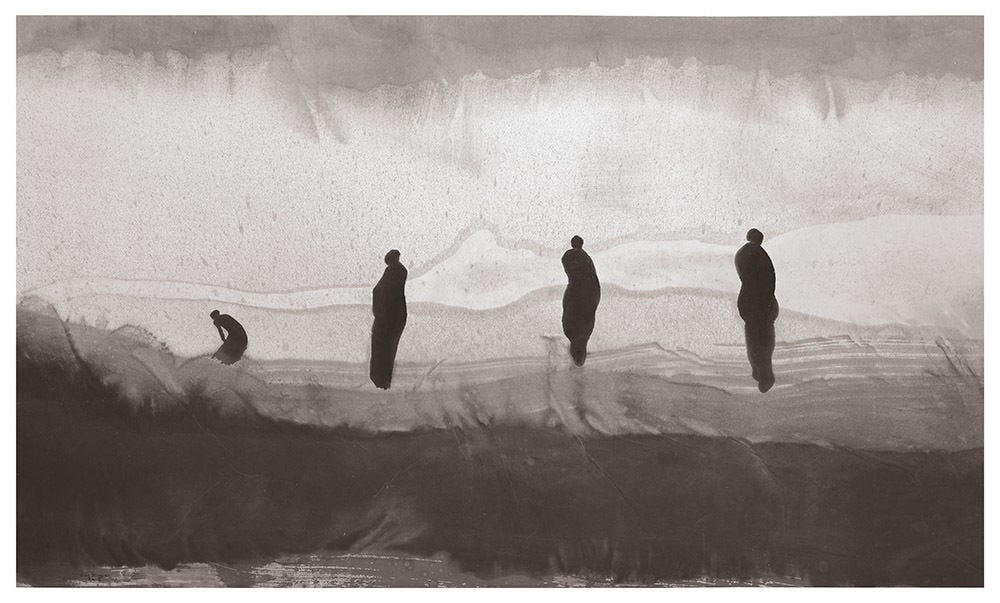
On the Shore (Sur la rive) 此岸, 2016 | Gao Xingjian.
Gao Xingjian, Chinese émigré (or exile) artist, was awarded the Nobel Prize for Literature in 2000. As a young adult, Gao Xingjian was already a writer with an obsessive desire for self-expression. However, he was aware that what he wrote was clearly at odds with Mao’s directive that literature and the arts must “serve the masses.”
During the Chinese Cultural Revolution, when stringent measures were imposed on intellectuals and artists, he knew that his writings were highly problematic and would never see the light of day. Yet as a compulsive writer, he continued to write. Even while undergoing “re-education” and living the life of a peasant in the 1970s, he continued to write but took the precaution of wrapping his manuscripts in plastic and burying them in the earth floor under the heavy water vat in his hut.
At the height of the Cultural Revolution, rather than risk having to face dire consequences for his accumulated writings, he burned several kilos of manuscripts (ten plays, and many short stories, poems, and essays). It took a long time to burn so much paper without creating smoke and arousing suspicions.
In 1987, he was able to travel to France as a painter and began what he described as his "second life". He sought political asylum in France and was granted French citizenship two years later: “After I went to France, I finally had an environment where I could work freely," he said. "So you could say I worked extremely hard, but I was very happy."
In an interview, he was asked what it means to be a writer either in exile or as part of a diaspora:
At one level, I think that in the twentieth century the problem of exile or alienation is particularly pronounced for writers and artists.
At another level, a more spiritual level, that exile also means overcoming ideologies and overcoming prevalent attitudes and trends, and so exile has also been a way of pursuing “no -isms” or overcoming ideologies.
At a third level artists tend to be on the margins of society. So from that perspective, exile is a kind of appropriate mental state, at least for artists. This is a good thing. If you are in the center of society, you will be receiving inputs and pressures from too many different areas, and that is not the kind of environment that an artist needs to cultivate his own creativity and his own thinking.
Gao represents the underrated yet increasingly frequent persons who are “in-between”— that is, in-between the still reigning paradigm of national and cultural identities.

It was after his final descent into near-blindness that Jorge Luis Borges drew this self-portrait for in the basement of Strand Bookstore in New York City.
One of the great writers to come out of Argentina, Borges shared with The New York Times, "I knew I would go blind, because my father, my paternal grandmother, my great-grandfather, they had all gone blind.”
He wasn’t exactly sorry to be blind. “A writer, or any man, must believe that whatever happens to him is an instrument, everything has been given for an end,” he wrote:
Everything that happens, including humiliations, embarrassments, misfortunes, all has been given like clay, like material for one’s art. One must accept it. . . If a blind man thinks this way, he is saved. Blindness is a gift. I have exhausted you with the gifts it has given me.
The self-portrait above, which he created by "using one finger to guide the pen he was holding with his other hand,” feels like a delineation of what has given shape to his soul. Crooks and turns. Full of the unexpected. After making the sketch, Borges entered the main part Strand and started "listening to the room, the stacks, the books," and afterward made a remarkable observation: "you have as many books as we have in our national library.”
The grace of transforming one’s personal crisis is no less noble than the heroic attempt of saving a nation. What is more interesting is how an individual, who is not a hero, find their path through disasters and crises.
And if everyone is a hero, then disasters and atrocities lose their meaning. It is only when certain people are heroes, and others are not that the tragedies and disasters take on meaning.

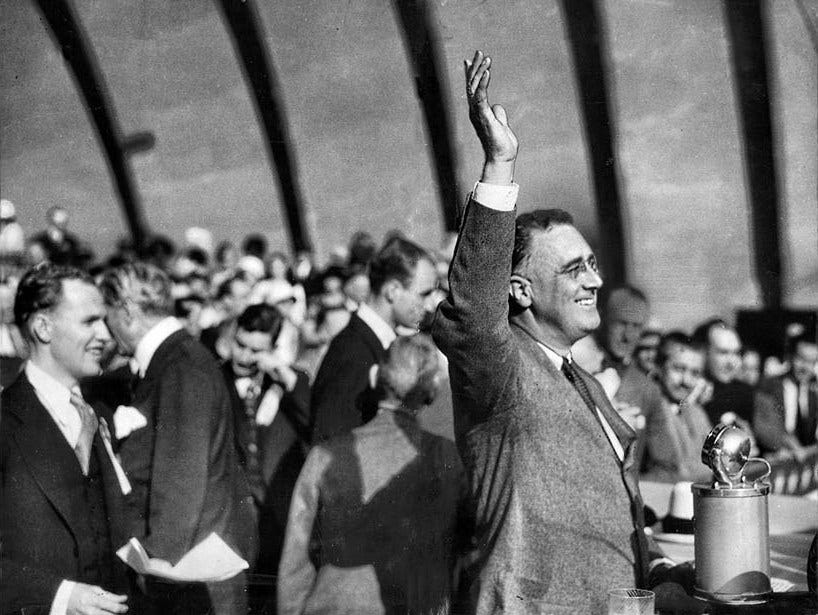
1932: FDR’S first presidential campaign
In a speech in 1932, President Roosevelt reminded a San Francisco audience of what had always distinguished the United States from other nations since its earliest days:
“At the very worst, there was always the possibility of climbing into a covered wagon and moving west where the untilled prairies afforded a haven for men to whom the East did not provide a place.”
What Roosevelt referred to was the myth of an open and ever-expanding frontier central to the American identity. Symbolizing a future of endless promise, it was the foundation of the United States’ belief in itself as an exceptional nation — democratic, individualistic, forward-looking. What happens when the frontier is no longer as boundless as envisioned, and eventually, we hit a wall?
In The End of the Myth, historian Greg Grandin shows that for centuries, America’s constant expansion served as a “gate of escape,” helping to deflect domestic political and economic conflicts outward. Grandin writes: “it is a symbol of a nation that used to believe that it had escaped history, or at least strode atop history, but now finds itself trapped by history.” Disenchanted and bewildered, we have become a country that increasingly defines itself by what it hates.”
I can’t help but feel reminiscent. What if the Internet is a new frontier, and that we’ve hit a wall?

Product philosophers
I first came across this idea when I saw Tristan Harris’ job title on Linkedin.
What a dream. I thought.

Since then, I’ve seen more and more tech PMs becoming philosophers, or philosophers becoming PMs. The philosophers now are building companies that create products that philosophize —

Tempo, the email app, has a dedicated philosophy section that explains how it’s philosophically different from other email apps. (It’s a beautiful app btw)

I have been a verbal huge fan of Whimsical, a visual workspace for teams. You can easily and quickly create wireframes, journey maps, mindmaps, and share with others.

Carl MH Barenbrug (@carlbarenbrug) curated a list of software that aligns with minimalistic principles. His central question is: how can we, as technologists, help to make the web more energy efficient?
None of these companies seems to be in a rush to fundraise, but instead, they are heads down to make sure they craft the most valuable experience for the users while being hyper-conscious of their impact on the environment.
Memes go collaborative

Koji wants to democratize interactivity by allowing users to customize memes, selfies, and web games using GIFs, audio clips, and so forth, based on the various templates created by independent developers.

See above to see an example of the type of weird stuff you can make. It’s quite addicting, and once I upload this game, anyone can remix it again to make it their own.
Users can leave tips for developers, and founder Dmitry Shapiro says there will soon be the capability for developers to charge upfront for their templates. Both users and developers can also receive tips for custom asset packs (images, GIFs, and audio clips) for people to use in remixing their Kojis.
Tools become universes

Miro is a whiteboard platform for distributed teams, with 5M+ users from around the world. Miroverse is a publishing platform, where members of the Miro community publish their work so that others can explore examples to get started right away. As a result, Miroverse was built in 3 months with 70+ templates from 60+ creators (!!!)
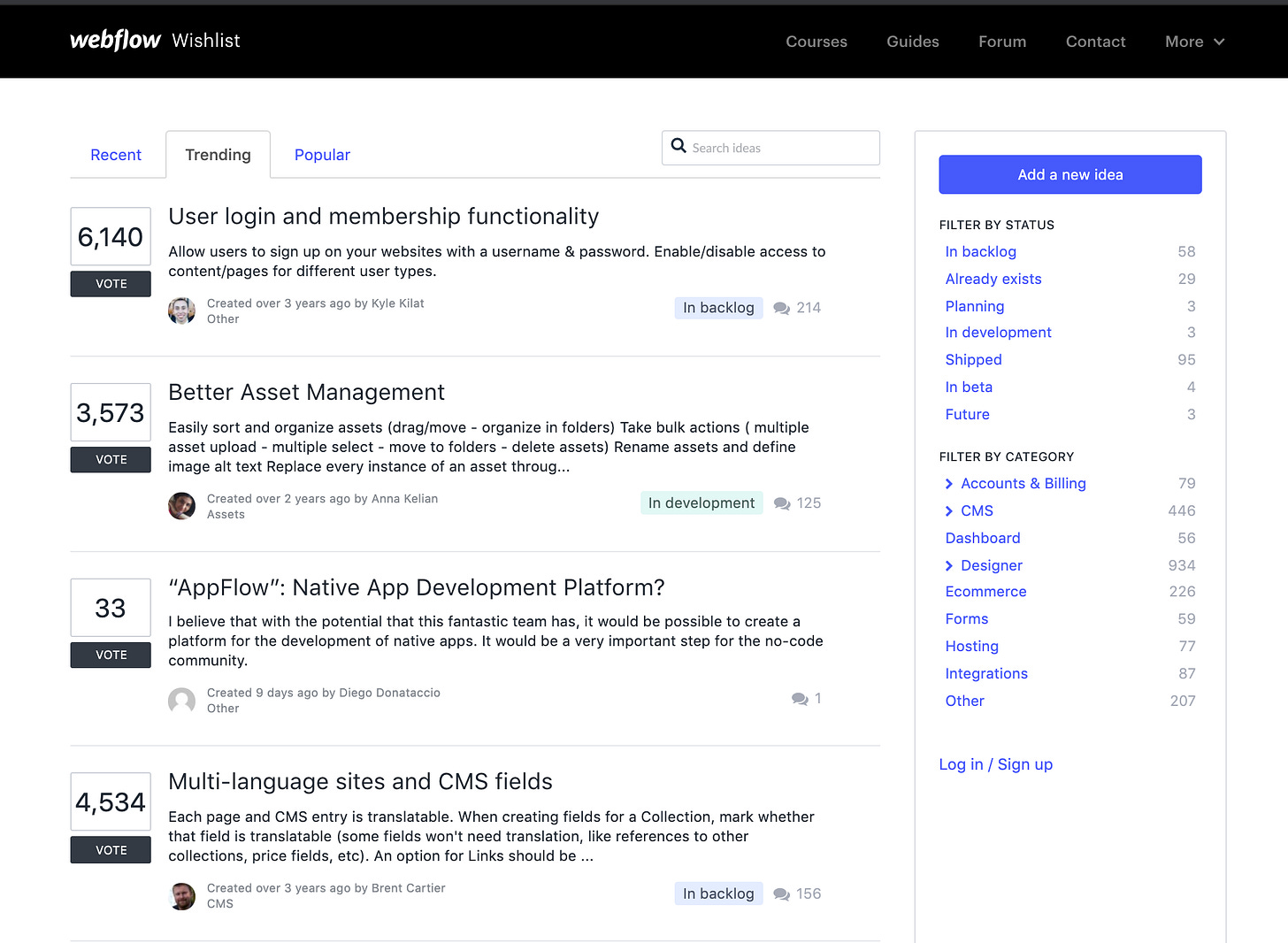
Webflow, on the other hand, built a feature wishlist for users to upvote what’s next on the roadmap. The forum comes with a reddit style readiness that welcomes everyone to “add a new idea”.
Soon enough… tools can’t call themselves a horizontal platform unless they’ve got a universe. The sky is not the limit, it’s the bare minimum.


Devin Allen gained national attention when his documentary photograph of the Baltimore Uprising was published on a Time Magazine cover in May 2015 — only the third time the work of an amateur photographer had been showcased there.

Allen has turned his attention towards arming the youth of Baltimore with cameras, not guns. He created the Through Their Eyes fundraiser to spread “hope and love through art” by training students from districts where arts education programs have been underfunded on how to use photography to express themselves. The proceeds will provide students with cameras, donated his time holding youth photography workshops, and organized an exhibition of the students’ work.
I found Devin through See In Black, a collective of Black photographers who uplift and invest in Black visibility.

🍋 S-1 Club // $LMND
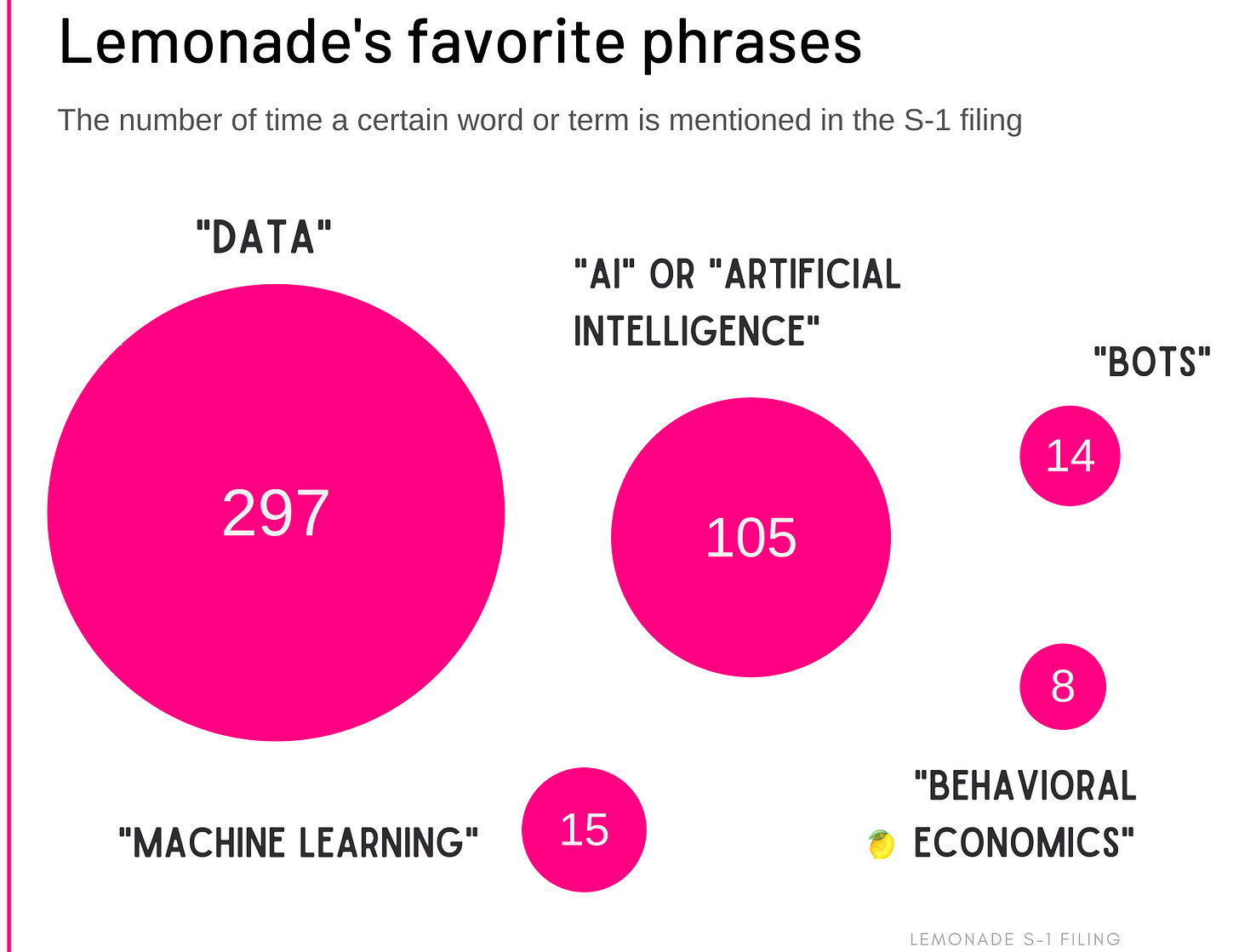
I worked with a group of incredible people on a piece of S-1 analysis for the recent Lemonade IPO. Read the whole thing here.
💫 Fakepixels x BobbleHuas

BobbleHaus is a newly launched streetwear brand promoting genderless and sustainable fashion to challenge existing barriers. Major alignment with why I started this newsletter, so we did a lil collab.
Q: What's a "big question" you can't wait for someone to figure out (that 'someone' could be you!)?
How to get more people to think independently? How can we create a safe space for everyone to express what they believe in?
💦3 Drops
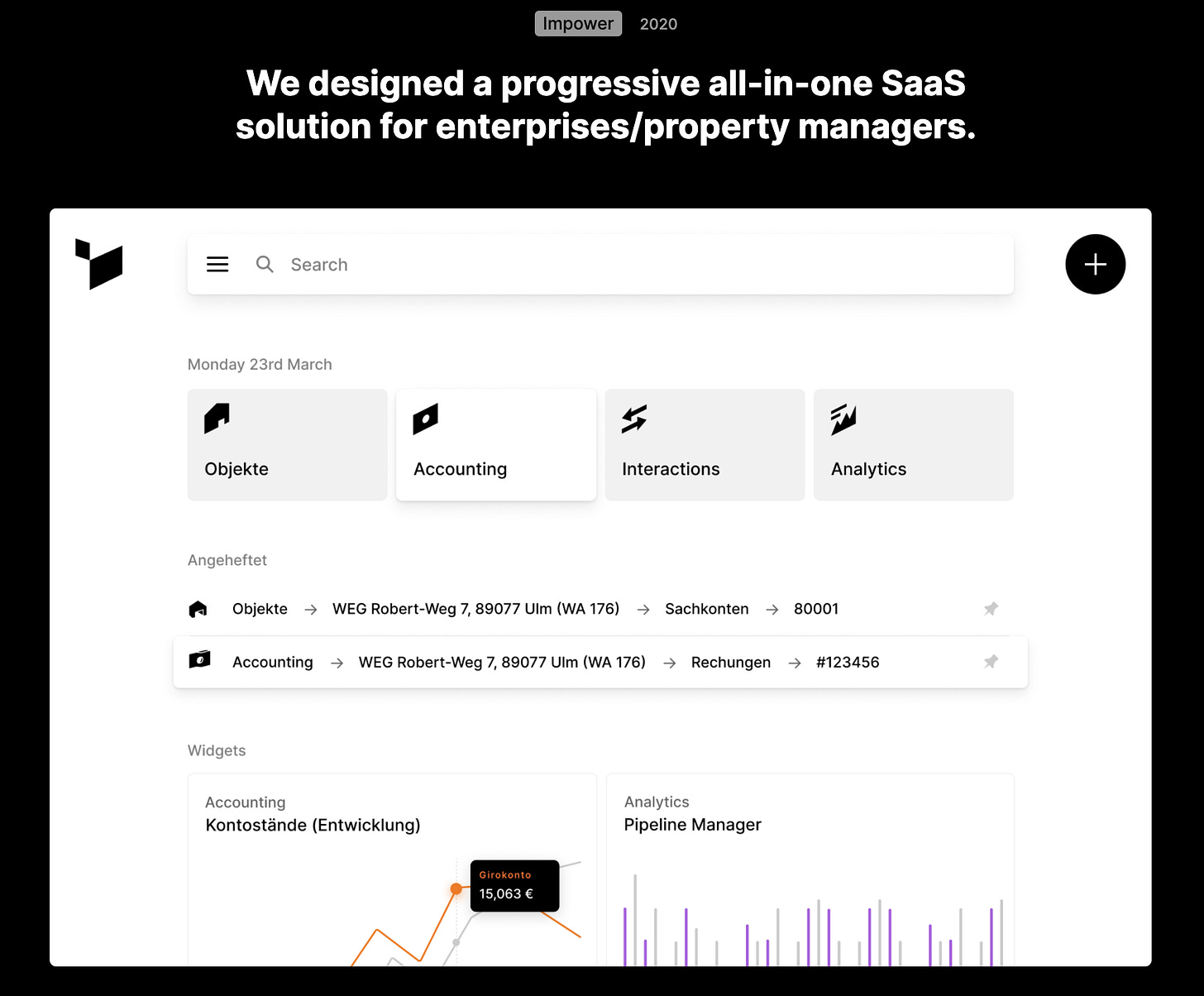
Are you SaaS companies that are looking for beautiful and functional product design? My friend Farzad at 3Drops is available for one b2b SaaS client project. Their recent portfolio not only raised from some of the best VCs, but also raised my standards for software design. Check them out.

Fakepixels is a space for courageous thoughts.We respect ideas, even dangerous ones. We believe in the power of deep thinking, nuanced dialogue, and creative courage.
We are a community with curious thinkers and restless builders who believe the future will be better than the status quo.
Sounds like you? Join the club and bring a friend.

Tina is a designer, writer, and investor who’s online 24/7 hunting for ideas and ventures built with grit and purpose. Born in China. Based in NYC. You can find her elsewhere on Twitter, Instagram, or a corner café.



